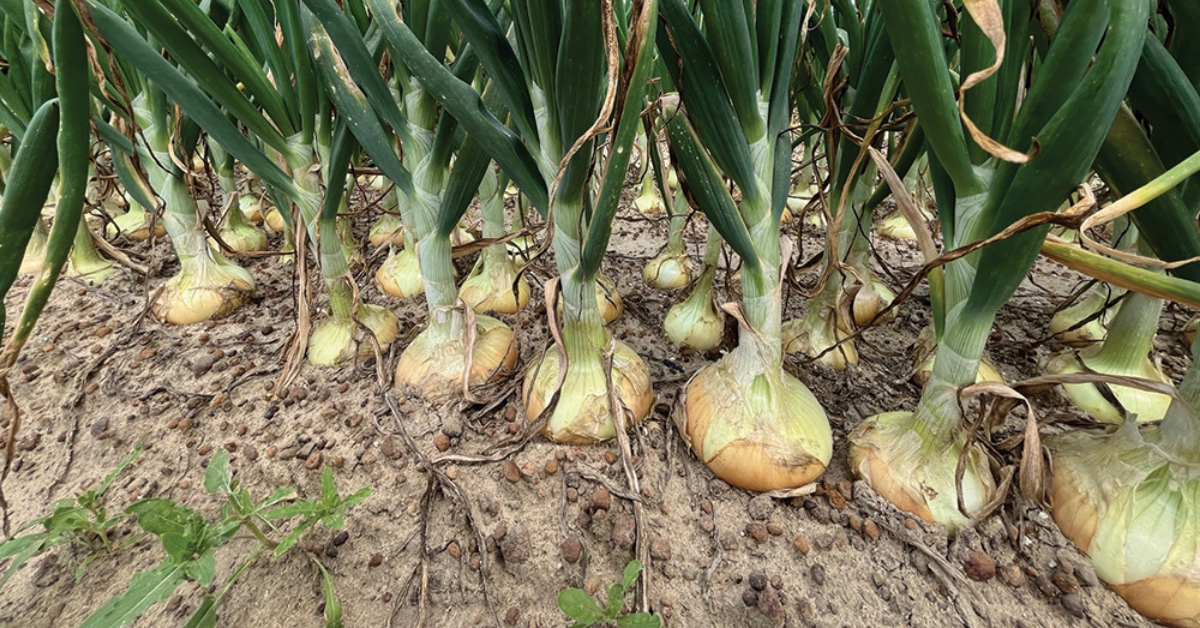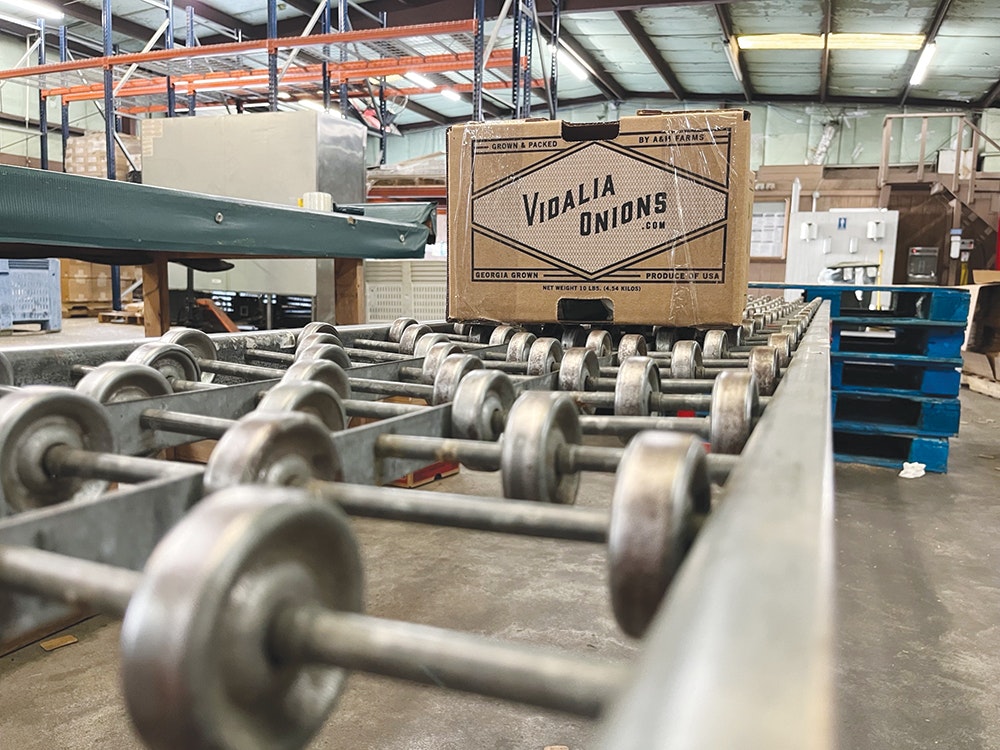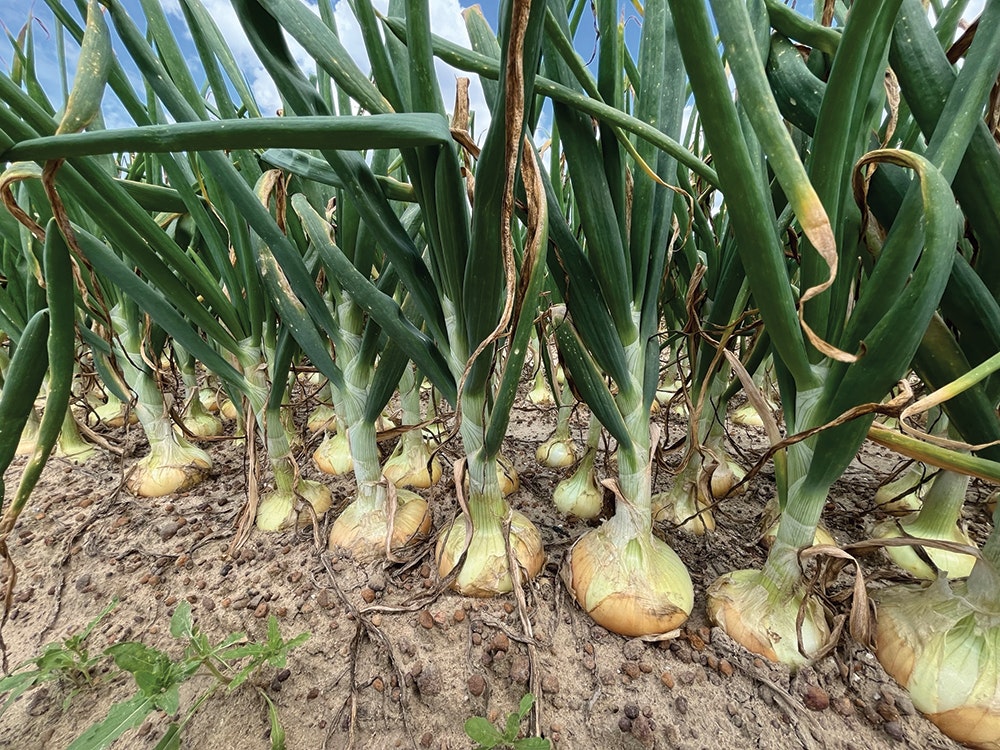Vidalia onion grower A&M Farms trials laser weeding, battles pests
July 25,2024

Technology, including autonomous robots, is a part of A&M Farms’ sweet onion production success.
Aries Haygood, president, grows Vidalia sweet onions with his wife, Megan, company co-owner whom the company’s initials represent. Though growing up in the Vidalia region, Aries had never seen a Vidalia in the field until he married into the business.
A&M has been trialing Carbon Robotics’ LaserWeeder since 2022. The experiment started in one of Haygood’s fields.

When the test began, the speed of the automated laser weed remover was abnormally slow. Within five months, however, speeds doubled. “Things like that will speed this whole industry’s acceptability of all this equipment,” Haygood said.
“Once it gets to where a laser weeder like that can deliver three to four acres an hour, it will be able to cover a lot of ground in custom weeding.”
A robot in A&M’s packinghouse raises cartons and places them on pallets as well as helps stack pallets onto trucks. While a learning process, the tech works well, Haygood said.

In the fields, Haygood said he expects automation and AI to perform chores including determining crop health faster than a naked eye. He said he’s viewed laser weeding systems on other crops that can zap more than 100,000 weeds an hour.
“It’s the way of the future,” he said. “It will allow for a job to be done with a lot fewer mistakes and more consistency. We couldn’t get enough help to afford and do that kind of work.”
Future tech
Haygood said he can see automation and AI doing for ag what it’s done for the auto industry.
“Anytime things can be a little more consistent, being as precise as it can be, and level things out, it helps us all, and is important for all of us as consumers as well, and will eventually save us money,” he said.

A&M owns drones and uses them to scout crops. The tech works well. Haygood predicts the tech, including cameras, will improve.
Haygood envisions a strong future with AI and robots helping in growing and packing vegetables.
“We know the tech is there,” he said. “It’s getting it to process and training it to work faster so it can be more efficient.”
The biggest pest threat to Vidalia onions is onion thrips, a parasite that feeds on leaves, allowing bacteria to enter through moisture.

On diseases, the biggest challenges are botrytis and center rot. Invisible to the human eye, center rot can break an onion’s neck and is detected only when the plants are in peril.
Haygood said he’s trying to guard against disease and pest threats by laying down clean seedbeds. “No one wants any kind of pest or disease in the crop, but we’re learning when we have them, and have to figure out why they come and what we can do to stop them,” he said.
South Georgia is a challenge. One year you can try something and feel it works, but try the exact same thing the next year and it doesn’t work, Haygood said. With all the rain the region receives, weed control is difficult to combat.
Soil matters
Haygood is paying more attention to the soil and is considering ways to combat soil erosion, including less tilling.
“The roots are basically the stomachs of our bodies,” he said. “If we provide good nutrition and healthy biology into the soil, then the roots living in the environment will take in the good stuff, which will make them healthier. Soil health is a lot bigger on my radar than it was in the past. I’m learning much more about it.”
Haygood said he’s trying to avoid over fertilizing, which can affect the soil’s biology.

“There’s so much going on in soil we don’t think about,” he said. “We think about it sometimes as being dirt. There’s a whole life going on underneath that is breaking-down different products and organic matters, trading that for the nutrients the roots need. At the end of the day, we want plants to be as healthy as possible so when my daughters eat the plant, they will consume something as healthy as can possibly be grown.”
Weather remains Haygood’s biggest growing challenge. Growers can hit long cold, wet and dry spurts.
“With the onion, when you start adding more unpredictable weather events and patterns, it makes it more of a guessing game,” he said. “Our science and tech allow us to be able to fertilize efficiently, to spray products if we have to, to help combat the pests and all to buy some extra weeks worth of time. That tech is there, but the challenging part of everything is the weather. And it’s just so unpredictable now and poses a bigger problem for us.”
At Georgia Southern University in Statesboro, where Aries earned a business/marketing degree, he met Megan, who was from Lyons, which neighbors Aries’ hometown of Vidalia. After Aries sold insurance, the couple returned to Vidalia country in 2007 and Aries began working for his father-in-law Terry Collins, co-founder of M&T Farms.
Aries began working at the bottom of Collins’ Vidalia growing operation before advancing to general manager. In 2020, Aries and Megan purchased and renamed the company.
Wanting to keep the family farming tradition going, Aries is trying to show his teenage daughters the numerous career opportunities offered in agriculture.
“If they don’t like seeing what I do, I at least want to get them to see the other aspects of ag,” he said. “We need the next generation of farmers to feed us. We’ve got to have food and water to provide us the essential items we need as a society to function.”
Link to Article in Vegetable Growers News
Tags: AgTech, Equipment, Grower profile, Onions, technology
